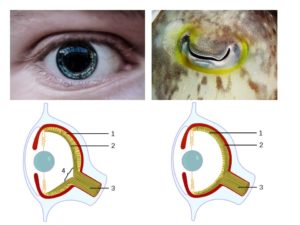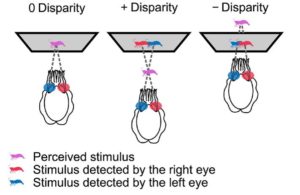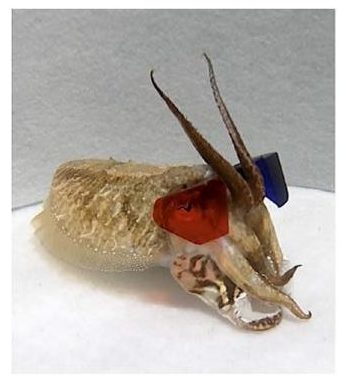For a long time, humans believed the ability to see the world in 3-D was a pretty complicated trait that was unique to us and other primates. It’s true – seeing in 3-D and perceiving depth (called stereopsis) is a very complicated process, requiring some pretty impressive mental math you aren’t even aware you’re doing!

Each of your eyes sees a single 2-D image. But because each of your eyes is positioned to see at a slightly different angle, your brain receives two, slightly different images of the same object. You can get an idea of the difference, or disparity, between the images generated by each of your eyes with a quick test: Focus on an object about 20 feet away from you. Close one eye and then hold your thumb up in front of your open eye so that it covers the image of the object you are focusing on. When you switch which eye you have open, the object is no longer covered by your thumb. Our brains use this disparity to perform some quick geometry calculations and figure out where the 3-D object actually is in space.
But this method is not the only way to see 3-D objects and perceive depth. In fact, over the years, we have found that more and more animals – cats, horses, birds, and even some insects – are capable of perceiving their world in three dimensions and not all of them rely on the same mental algorithms we do. Learning more about which animals can see in 3-D and how their brains process this information can tell us more about why 3-D vision and depth perception has evolved in different groups of animals and might even be able to give us new ways to teach machines to visualize 3-D objects aside from the complex human-inspired systems we use now.

Studying different animals can teach us about how our own vision brains evolved
Cephalopods (octopods, squids, cuttlefish, and nautiluses) serve as an interesting group to study how vision has evolved differently in humans and invertebrates. Even though humans and cephalopods have drastically different evolutionary lineages and live in wildly different environments, both groups have independently evolved strikingly similar eyes – meaning that the process of evolution has taken two different animals in two different settings and settled on the same basic eye design. Yet, our brains and the way in which we process the information from those similar eyes, is far from the same. Scientists are, therefore, curious to see just how a cephalopod brain processes visual information and how it differs from the way in which our brains function.
One way to test this is to see if cephalopods see in 3-D and have depth perception. Scientists from the University of Cambridge and the University of Minnesota decided to test if the forward facing eyes in cuttlefish allow them to have binocular vision (like our own) and perceive depth. But how can scientists tell if cuttlefish can see in 3-D? Well, you outfit them with cuttlefish 3-D glasses, of course!
3-D glasses do more than make a cuttlefish look cool
3-D glasses use polarized filters to show each of your eyes the same object from slightly different locations, tricking your brain into perceiving a 3-D object. Because 3-D glasses enable scientists to change what each eye sees independently, they can change the disparity between the images shown to the right and left eyes, thereby tricking the brain into thinking the “real” image is closer or farther away from the viewer.

Using this method, the scientists were able to test if cuttlefish used depth perception when hunting by showing them different images of prey through 3-D glasses, then altering the disparity between images (and the perceived distance of a “real” prey) shown to the cuttlefish. Scientists could tell where the cuttlefish thought the “real” prey was based on how and where the cuttlefish tried to strike at the prey item. You can watch a video of how the cuttlefish’s response to the different images was measured here.
When shown prey images with different disparity, the cuttlefish would reposition themselves and adjust their striking behaviors and distance to account for the change in the position of the “real” prey item they perceived (watch a video here). Furthermore, if the scientists showed the cuttlefish an image to only a single eye (simulating monocular, or single eye, vision) the cuttlefish’s striking efficiency decreased (watch the video here). These data suggest that the cuttlefish do in fact coordinate information from both eyes, using both binocular vision and depth perception to see the world around them.
Even though cuttlefish eyes and their ability to see in 3-D is convergent to that seen in humans, cuttlefish brains likely use a completely different algorithm to allow these invertebrates to perceive depth. The more we find out the difference in these visual algorithms could teach us a lot about how vision evolved across the animal kingdom and how we can make use of these algorithms for machine learning.
Podcast: Play in new window | Download
I received my Master’s degree from the University of Rhode Island where I studied the sensory biology of deep-sea fishes. I am fascinated by the amazing animals living in our oceans and love exploring their habitats in any way I can, whether it is by SCUBA diving in coral reefs or using a Remotely Operated Vehicle to see the deepest parts of our oceans.

